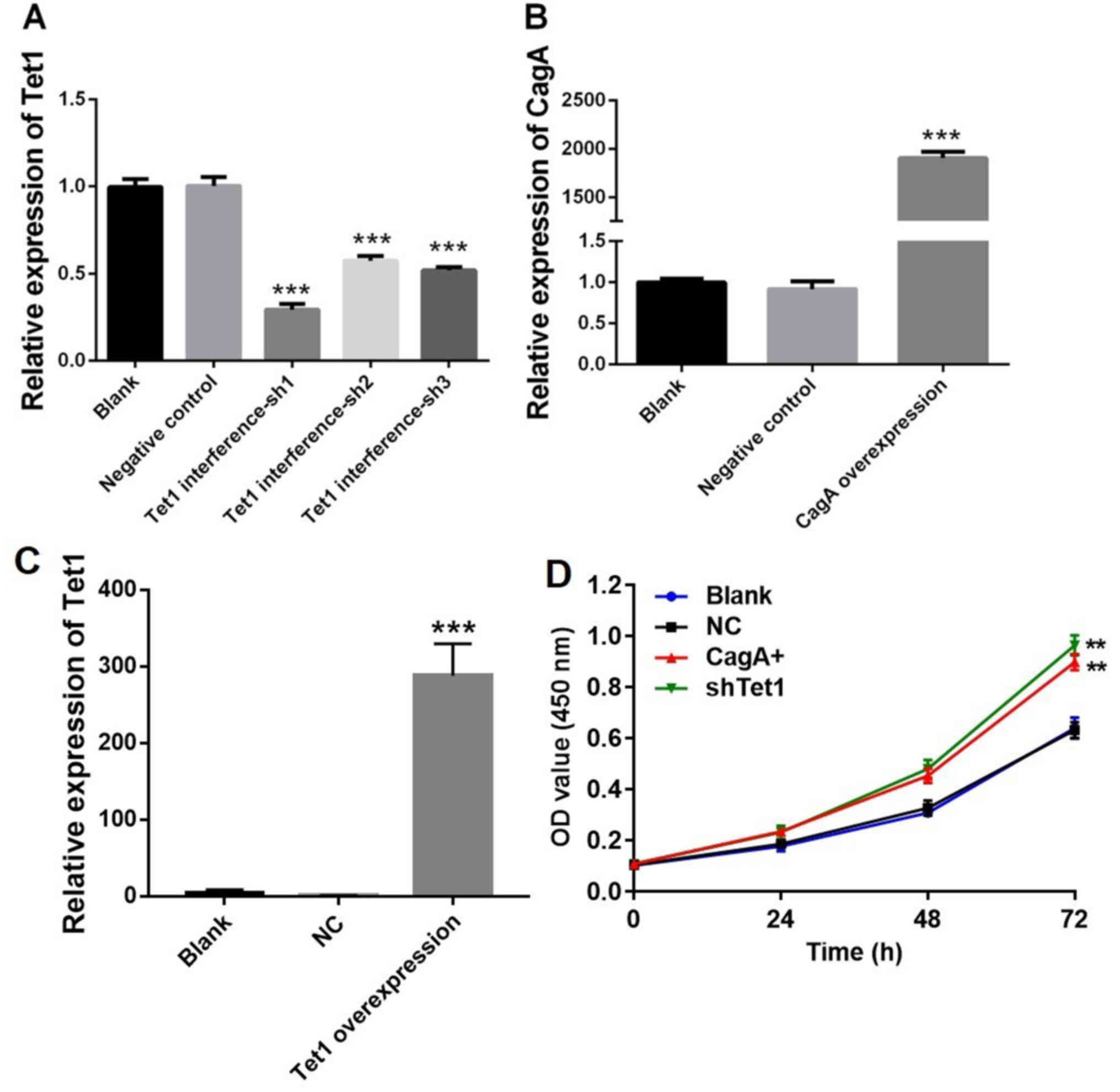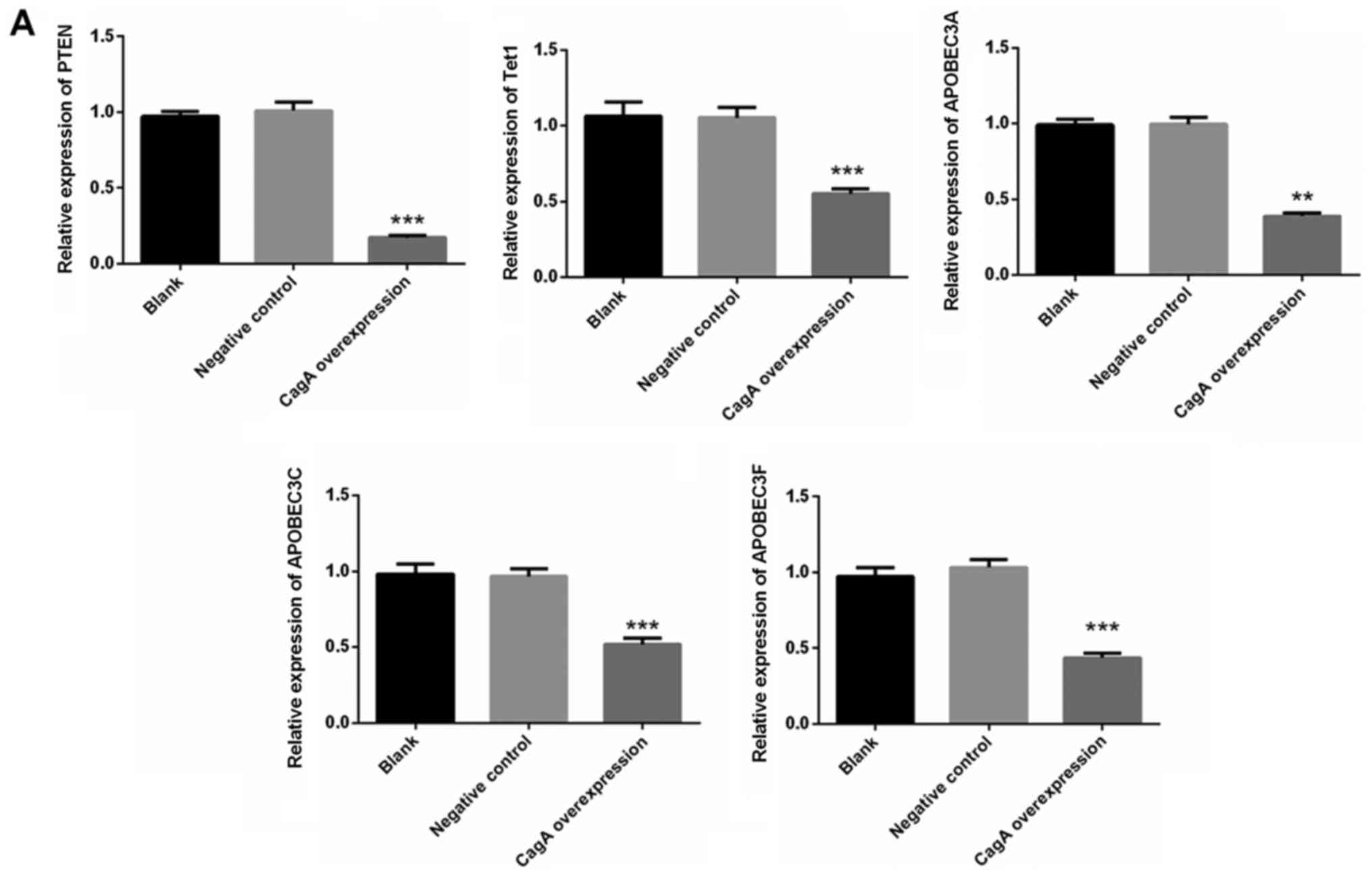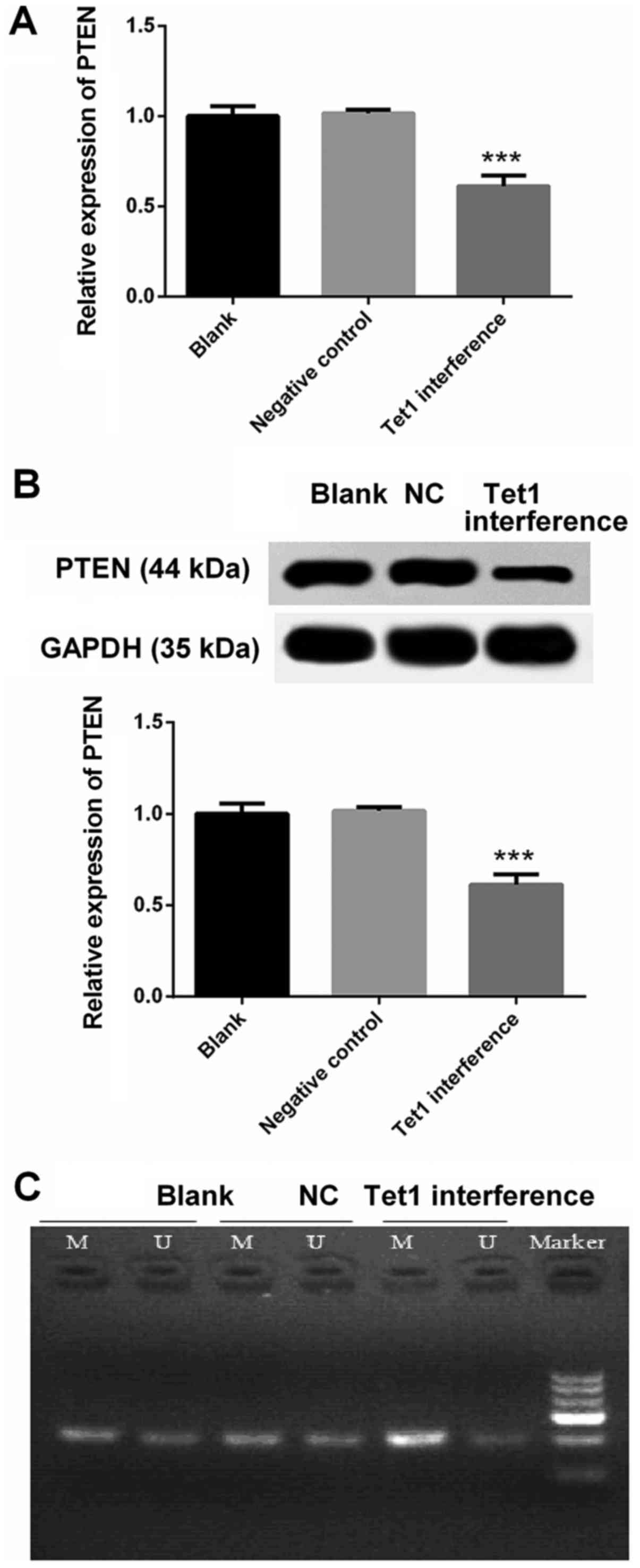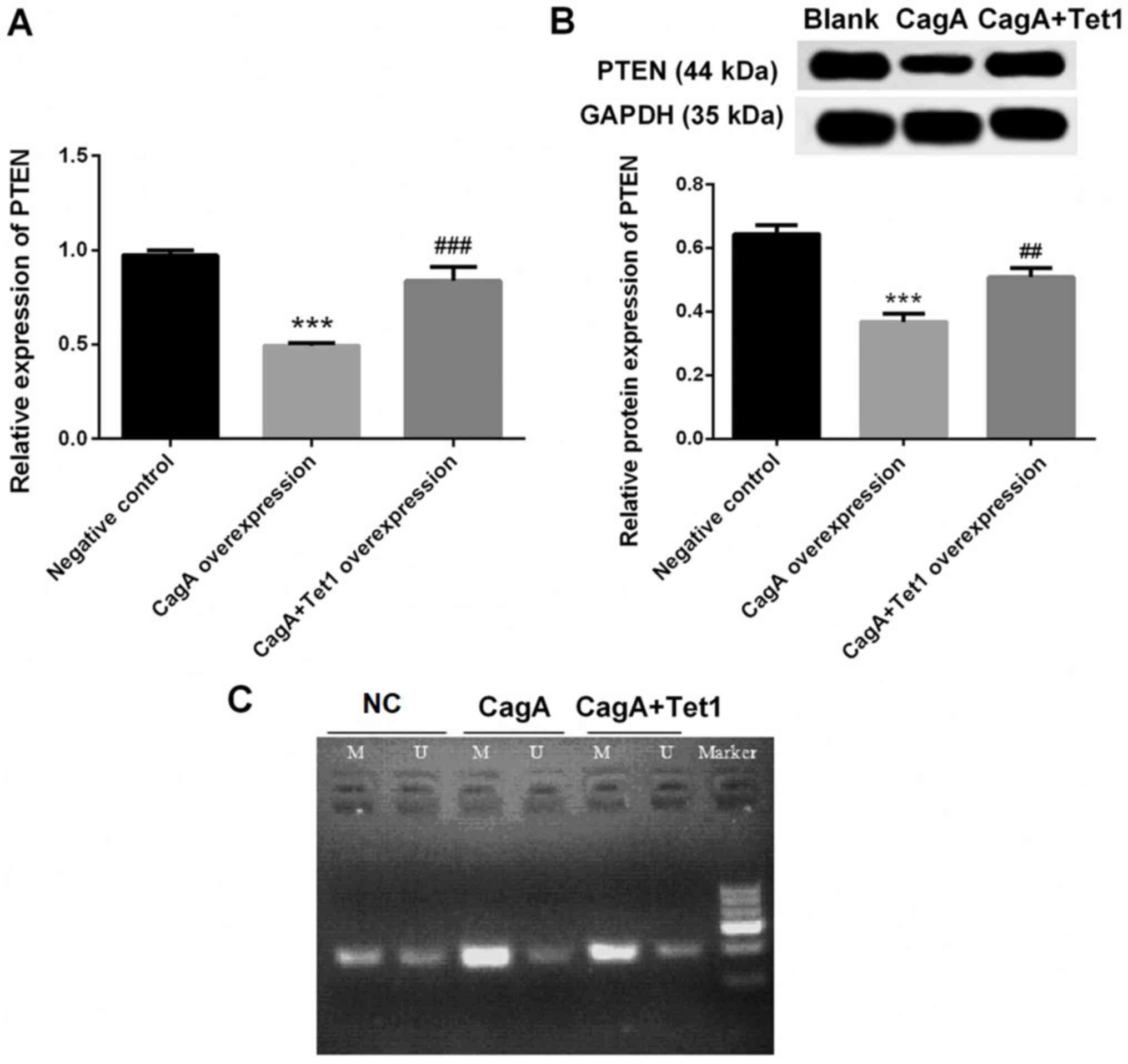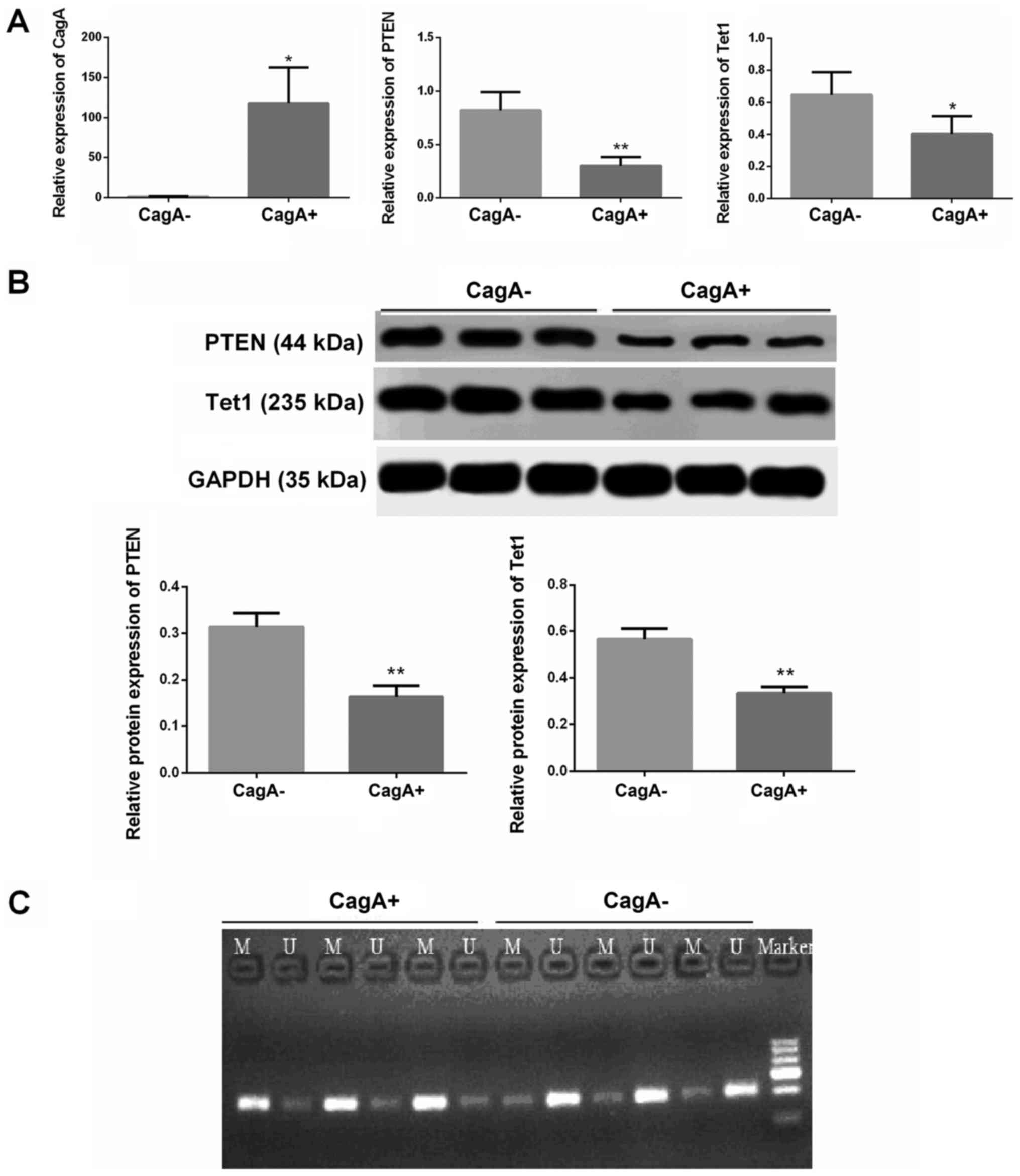CagA increases DNA methylation and decreases PTEN expression in human gastric cancer
- Authors:
- Published online on: November 13, 2018 https://doi.org/10.3892/mmr.2018.9654
- Pages: 309-319
-
Copyright: © Zhang et al. This is an open access article distributed under the terms of Creative Commons Attribution License.
Abstract
Introduction
Gastric cancer is one of the most common types of cancer worldwide. The global incidence of gastric cancer has declined over recent decades (1); however, due to aging in the world population, the absolute number of new cases per year is increasing. Furthermore, there is a recent upward trend in young patients with gastric cancer (2); therefore, gastric cancer remains an important cause of cancer-associated mortality.
Cytotoxin-associated gene A (CagA) has been reported to be associated with gastric diseases, particularly peptic ulcer disease (3). In total, 85–100% patients with duodenal ulcers are infected with CagA+ Helicobacter pylori (H. pylori) strains (4). The origin of H. pylori strains has been reported to serve an important role in the rates of gastric cancer, which may be associated with differences in the capacity of different strains to express CagA. Notably, the incidence of precancerous lesions and gastric cancer is higher in patients with CagA+ strains (5). Furthermore, 88% of animals infected with a rodent-adapted strain of CagA-producing human H. pylori developed gastric dysplasia within 4 weeks, and 75% of animals developed gastric adenocarcinoma by week 8 (6). In addition, specific amino acid sequences in the CagA protein have been revealed to be associated with an increased risk of malignancy (7); however, the mechanism by which CagA affects the expression of genes in gastric cancer remains elusive.
The phosphatase and tensin homolog (PTEN) gene, which is located on chromosome 10q23, is a tumor-suppressor gene (8–10). It has been reported to regulate the phosphoinositide-3-kinase-protein kinase B (AKT) and mechanistic target of rapamycin signaling pathways, which serve important roles in apoptosis, cell cycle progression and cell proliferation. Loss of function of PTEN has been reported to result in oncogenesis and somatic mutations in various malignancies (11). Tet methylcytosine dioxygenase (Tet)1 has been reported to exert its tumor-suppressor function in gastric cancer through interactions with the p53-enhancer of zeste 2 polycomb repressive complex 2 subunit (EZH2) signaling pathway. Tet1 suppresses cancer formation via inhibition of the oncogenic protein EZH2 and activation of p53, possibly via DNA demethylation (12). However, the associations between CagA, PTEN and Tet1 in gastric cancer remain unclear. Therefore, the present study aimed to investigate the interactions between CagA, PTEN and Tet1 in gastric cancer.
Materials and methods
Reagents
Primers, TRIzol® reagent, SuperScript III Reverse Transcriptase, SYBR Green I and DEPC H2O were purchased from Invitrogen (Thermo Fisher Scientific, Inc., Waltham, MA, USA). The RNase inhibitor was purchased from Fermentas (Thermo Fisher Scientific, Inc., Pittsburgh, PA, USA). Platinum Taq DNA polymerase, oligo dT/primer and 100 mM dNTPs were purchased from Invitrogen (Thermo Fisher Scientific, Inc.) and used for PCR. Dulbecco modified Eagle's medium (DMEM) was purchased from Gibco (Thermo Fisher Scientific, Inc.).
Construction of recombinant plasmids and lentiviral packaging
HEK 293T cells (American Type Culture Collection, Manassas, VA, USA) and human gastric cancer cell line HGC-27 cells were cultivated in Dulbecco modified Eagle's medium (DMEM, Invitrogen; Thermo Fisher Scientific, Inc.) with 10% of fetal bovine serum (FBS; Invitrogen; Thermo Fisher Scientific, Inc.) in a humidified incubator with 5% CO2 at 37°C. The human gastric cancer cell line HGC-27 was purchased from RIKEN Bioresource Center (Tsukuba, Japan); this cell line is derived from a metastatic lymph node, and is a highly metastatic cell line due to its undifferentiated characteristics. The Tet1 catalytic domain (NM_030625.2) was used to design three short hairpin RNAs (shRNAs) (Table I). Upon annealing, shRNA was treated with T4 DNA polymerase in the presence of dATP, and then annealed with the pds019-pl6.3-SHRNA-BSD vector (Novagen, EMD Millipore, Billerica, MA, USA). Then, the annealed complex was transformed into E. coli host strain. The recombinant plasmids were sequenced, and named CL946-1, CL946-2 and CL946-3. In addition, the Tet1 catalytic domain was cloned into a PDS087_pL6-TO-V5-GIM vector (Novagen; EMD Millipore) using the restriction enzyme site NheI/AscI. The recombinant plasmid was named CL981_pL6-TO-V5-tet1-CD. Similarly, a CagA (AB015416.1) overexpression vector was generated. Subsequently, packaging mix (9 µg; Thermo Fisher Scientific, Inc.) and recombinant lentiviral plasmids (3 µg) were added into Opti-Minimum Essential Medium (MEM, Thermo Fisher Scientific, Inc.) and mixed. In addition, Lipofectamine® 2000 (36 µl; Invitrogen; Thermo Fisher Scientific, Inc.) was mixed with Opti-MEM (1.5 ml), and incubated at room temperature for 5 min. The plasmid solution and diluted Lipofectamine® 2000 were then mixed, and incubated at room temperature for 5 min. The mixture was added into a culture dish with HEK 293T cells, and the cells were cultured for 48 h in the conditions described above. The cell supernatant was then collected, centrifuged at 1,500 × g for 10 min at room temperature, and filtered. The virus solution was then condensed by centrifuging at 50,000 × g for 2 h at 4°C, and resuspended in DMEM. Tet1 interference (VL946_PDS19-shTET1), Tet1 interference (VL946_PDS19-shTET2), Tet1 interference (VL946_PDS19-shTET3), Tet1 overexpression (LV576_pL6-TO-V5-tet1-CD), CagA overexpression and negative control viruses were derived. HGC-27 cells were maintained in DMEM with 10% of fetal bovine serum in a humidified incubator with 5% CO2 at 37°C and were plated into cell plates (60 mm) at 4×105 cells/well overnight. HGC-27 cells were infected with CL946-1, CL946-2 and CL946-3 viruses for 3 days and quantitative polymerase chain reaction (qPCR) was used to detect interference efficiency. To determine the viruses transduction efficiency in HGC-27 cells, GFP expression was examined by microscopy at different multiplicities of infection (MOIs) on day 3 following infection.
Table I.Sequences of shRNAs used for vector construction and primers used for reverse transcription-quantitative polymerase chain reaction. |
Cell viability assay
Cell viability was measured using the Cell Counting kit 8 (CCK-8; Dojindo Molecular Technologies, Inc., Kumamoto, Japan). Briefly, HGC-27 cells (5×103 cells/well) were seeded into 96-well plates and cultured overnight. Subsequently, cells were infected with TET1 interference or CagA overexpression viruses for 24, 48 or 72 h. The medium was then removed and 10 µl CCK-8 solution was added to each well. After 4 h, cell viability was detected using a plate reader at a wavelength of 450 nm.
Reverse transcription (RT)-qPCR
The mRNA expression levels of PTEN, Tet1, apolipoprotein B mRNA editing enzyme catalytic subunit (APOBEC)3A, APOBEC3C, APOBEC3F, Ras, c-myc, c-met, estrogen receptor 2 (ESR2), Tet2, Tet3, acidic repeat containing (ACRC), activation-induced cytidine deaminase (AICDA), alkB homolog 1, histone H2A dioxygenase (ALKBH1), alkB homolog 2, α-ketoglutarate dependent dioxygenase (ALKBH2), apurinic/apyrimidinic endodeoxyribonuclease 1 (APEX1), APOBEC2, FTO, α-ketoglutarate dependent dioxygenase (FTO) and thymine DNA glycosylase (TDG) in HGC-27 human gastric carcinoma cells were detected by RT-qPCR. All these genes have been reported to have close associations with gene methylation/demethylation (13). Total RNA was extracted using TRIzol® reagent, according to the manufacturer's protocol. A universal cDNA synthesis kit (Invitrogen; Thermo Fisher Scientific, Inc.) was used for RT. Each reaction contained 0.5 µl random primers (0.2 µg/µl) and 1 µl SuperScript III reverse transcriptase (200 U/µl). The specific primers used for RT-qPCR are listed in Table I. PCR was performed using a SYBR qPCR kit (Invitrogen; Thermo Fisher Scientific, Inc.). The PCR conditions were as follows: Predenaturation at 95°C for 2 min, followed by 40 cycles of denaturation at 95°C for 10 sec, annealing at 60°C for 30 sec and polymerization at 70°C for 45 sec, followed by 1 cycle of melting curve at 95°C for 15 sec, 60°C for 60 sec and 95°C for 15 sec. PCR was performed using a CFX96 Touch™ Real-time PCR Detection system (Bio-Rad Laboratories, Inc., Hercules, CA, USA). Gene expression was determined and normalized to β-actin. The primers for β-actin were as follows: Forward, 5′-AGGGAAATCGTGCGTGAC-3′ and reverse, 5′-CGCTCATTGCCGATAGTG-3′. The 2−ΔΔCq method was used to analyze PCR results (14). The fluorophore used for qPCR was included in the SYBR qPCR kit.
Detection of methylation status of PTEN by methylation-specific PCR
Promoter methylation of the PTEN gene was determined by methylation-specific PCR. Genomic DNA from HGC-27 cells as well as control specimens were subjected to bisulfite modifications using an EZ DNA Methylation-Gold kit (Zymo Research Corp., Irvine, CA, USA) in accordance with the manufacturer's protocol. DNA (500 ng) was treated with sodium hydrogen sulfite at 50°C for 16 h. Unmethylated cytidine was deaminated and converted into uracil, whereas methylated cytidine remained unchanged. Based on these alterations, primers to amplify methylated and unmethylated PTEN sequences by PCR were designed using MethPrimer (http://www.urogene.org/cgi-bin/methprimer/methprimer.cgi; Table II). PCR was performed using the following conditions: An initial melting step of 10 min at 95°C; followed by 50 cycles of 20 sec at 95°C, 20 sec at 59°C and 45 sec at 72°C with a final elongation step of 4 min at 72°C in a CFX96 Touch™ Real-time PCR Detection system (Bio-Rad Laboratories, Inc., Hercules, CA, USA). 3.5% Agarose gel electrophoresis (Thermo Fisher Scientific, Inc.) was used to detect methylation status.
Western blot analysis
The protein expression levels of PTEN and Tet1 were detected by western blot analysis. Cells or tissues were lysed in lysis buffer (cat. no. P0013; Beyotime Institute of Biotechnology, Haimen, China) with protease and phosphatase inhibitors (cat. no. P1045; Beyotime Institute of Biotechnology) at 4°C. The lysis mixture was centrifuged at 10,000 × g for 10 min at 4°C, and the supernatant containing cellular proteins was used in subsequent experiments. The protein concentration was determined using a bicinchoninic acid kit. Subsequently, proteins (40 µg/lane) were separated by 10% SDS-PAGE (120 V) and the separated proteins were transferred to polyvinylidene fluoride membranes (cat. no. FFP24; Beyotime Institute of Biotechnology) at 100 V for 2 h. After blocking with 5% non-fat milk for 1 h at room temperature, the membranes were incubated with primary antibodies against PTEN (1:400, cat. no. ab32199), Tet1 (1:400, cat. no. ab191698) and GAPDH (1:400, cat. no. ab8245) at 4°C overnight. The membranes were then washed with Tris-buffered saline containing 0.5% Tween 20, and were incubated with horseradish peroxidase-conjugated goat anti-rabbit secondary antibody (1:5,000, cat. no. ab150077) at room temperature for 1 h. All antibodies were purchased from Abcam (Cambridge, MA, USA). The membranes were then washed and incubated in enhanced chemiluminescence solution (cat. no. P0018A; Beyotime Institute of Biotechnology), and the images were captured on film (FF057; Beyotime Institute of Biotechnology) in a dark room. The experiments were repeated three times. Blot images were semi-quantified in grayscale using ImageJ (version 2.0; National Institutes of Health, Bethesda, MD, USA).
Gastric cancer tissue sample collection
A total of 12 patients with gastric cancer were enrolled between April 2017 and May 2018 for the study at the Affiliated Hospital of Jining Medical University (Jining, China), and gastric cancer was confirmed pathologically. Patient tumor tissues were obtained during surgery. All patients provided written informed consent and the study was approved by the Institutional Review Board/Ethics Committee of the Affiliated Hospital of Jining Medical University. The clinical information of the patients is provided in Table III.
Statistical analysis
Statistical data were analyzed by GraphPad Prism version 5.0 software (GraphPad Software, Inc., La Jolla, CA, USA). Data are presented as the means ± standard deviation. Differences between more than two groups were compared by one-way analysis of variance followed by the Bonferroni post-hoc test. Differences between two groups were compared by Student's t-test. P<0.05 was considered to indicate a statistically significant difference.
Results
Tet1 interference and CagA overexpression in HGC-27 cells
Initially, HGC-27 cells were infected with viruses carrying Tet1 interference or CagA overexpression vectors. Relative expression levels of Tet1 and CagA were detected by RT-qPCR. The expression levels of Tet1 in HGC-27 cells were significantly decreased by Tet1 interference compared with in the negative control group (P<0.001; Fig. 1A). Since Tet1 interference-sh1 exerted the best inhibitory effect on the cells, it was used in subsequent experiments. In addition, compared with in the negative control group, infection of the cells with CagA or Tet1 overexpression vectors markedly increased the expression of CagA and Tet1, respectively (P<0.001; Fig. 1B and C). Furthermore, Tet1 interference or CagA overexpression significantly enhanced HGC-27 cell viability compared with in the control group (P<0.01; Fig. 1D). These results indicated that Tet1 interference, Tet1 overexpression and CagA overexpression were successfully achieved.
Expression levels of PTEN, Tet1, APOBEC3A, APOBEC3C and APOBEC3F are significantly decreased in the CagA overexpression group
RT-qPCR was used to detect gene expression in HGC-27 cells under the condition of CagA overexpression. As shown in Fig. 2A, the mRNA expression levels of PTEN, Tet1, APOBEC3A, APOBEC3C and APOBEC3F were significantly decreased in the CagA overexpression group compared with in the negative control group (P<0.01). However, there were no significant differences regarding the expression of Ras, c-myc, c-met, ESR2, Tet2, Tet3, ACRC, AICDA, ALKBH1, ALKBH2, APEX1, APOBEC2, FTO or TDG in the cells (Fig. 2B).
Decreased expression of PTEN in HGC-27 cells with Tet1 interference is associated with its increased methylation
RT-qPCR and western blotting were used to detect the mRNA and protein expression levels of PTEN, respectively. Compared with in the negative control group, the mRNA and protein expression levels of PTEN were markedly decreased in HGC-27 cells with Tet1 interference (P<0.001; Fig. 3A and B). The decreased expression of PTEN in the Tet1 interference group was associated with its increased methylation (Fig. 3C).
Decreased expression of PTEN in HGC-27 cells with CagA overexpression is reversed by Tet1 overexpression
Compared with in the negative control group, the mRNA and protein expression levels of PTEN were markedly decreased in HGC-27 cells with CagA overexpression (P<0.001; Fig. 4A and B), which was significantly reversed by Tet1 overexpression (P<0.01; Fig. 4A and B). In addition, the decreased expression of PTEN in the CagA overexpression group was associated with its increased methylation in the cells, whereas Tet1 overexpression attenuated this methylation (Fig. 4C).
Expression of PTEN and Tet1 is markedly decreased in CagA+ gastric cancer tissues
According to the expression of CagA, gastric cancer tissues were grouped into a CagA− or a CagA+ group (Fig. 5A). Immunohistochemistry was used to detect the expression of CagA. If CagA was expressed in the gastric cancer tissues, it was designated the CagA+ group. If CagA was not expressed in the gastric cancer tissues, it was designated the CagA− group (data not shown). The results indicated that the expression levels of PTEN and Tet1 were significantly decreased in the CagA+ gastric cancer tissues compared with in CagA− gastric cancer tissues (Fig. 5A and B; P<0.05). In addition, the decreased expression of PTEN in CagA+ gastric cancer tissues was associated with its increased methylation (Fig. 5C).
Discussion
The present study demonstrated that CagA may significantly decrease the expression of PTEN, Tet1, APOBEC3A, APOBEC3C and APOBEC3F in human gastric cancer. The results suggested that CagA decreased PTEN expression by increasing methylation levels, and decreased expression of PTEN was significantly attenuated by Tet1.
The risk of gastric cancer differs among various strains of H. pylori. Strains with virulence factors, including CagA and vacuolating cytotoxin A, are more likely to be associated with precancerous lesions and gastric cancer (15–17). A specific motif (AATAAGATA) has been revealed to be linked to the capacity of H. pylori to express CagA (18). Highly virulent strains of H. pylori produce CagA-modulated c-met receptor signal transduction pathways in vitro, which may influence the initiation and progression of gastric cancer (19).
Gastric carcinogenesis has been proposed to involve an initial stage of dedifferentiation, including gastric atrophy, followed by abnormal redifferentiation, including intestinal metaplasia. This process is mediated by the effects of H. pylori infection, particularly CagA+ strains, on β-catenin (20,21). Apical junctions are disrupted by CagA expression, and mechanisms that maintain the differentiation of normal epithelium, including cell adhesion, cell polarity and inhibition of migration, are also disturbed by CagA expression in vitro (22). In addition, proteolytic cleavage of E-cadherin is induced, and E-cadherin-dependent cell-to-cell contact is disrupted by CagA (23). Formation of the E-cadherin/β-catenin complex is also impaired by CagA, thus leading to the accumulation of β-catenin in the cytoplasm and nucleus, and constitutive transcription of intestinal differentiation markers. Nuclear localization of β-catenin has also been reported to be present in a carcinogenic human gastric cell line, but not in a non-carcinogenic clinical isolate (6,24).
In the present study, a highly metastatic gastric cancer cell line, HGC-27, which was initially isolated from an Asian patient with gastric cancer, was used. This cell line is derived from a metastatic lymph node and may provide a novel perspective for the role of CagA in gastric cancer metastasis. The results of the present study demonstrated that CagA significantly decreased the expression levels of PTEN and Tet1 in this human gastric cancer cell line. In addition, it was revealed that CagA decreased PTEN expression by increasing its methylation level, which was significantly attenuated by Tet1. PTEN serves an important role in apoptosis, cell cycle progression and cell proliferation, and functions as a tumor-suppressor gene. It has been reported that Tet1 exerts its tumor-suppressor function in gastric cancer possibly via DNA demethylation (12). Tet1 has also been reported to inhibit the growth and metastasis of gastric cancer by demethylation and re-expression of PTEN. Tet1 suppresses the cell growth, migration and invasion of gastric cancer via demethylation of CpG islands in the PTEN promoter region, by increasing 5-hydroxymethylcytosine. The re-expressed PTEN has been revealed to downregulate the activity of AKT and focal adhesion kinase (25). This may explain how Tet1 attenuated CagA-induced methylation and PTEN downregulation in gastric cancer in the present study. The present findings have provided novel mechanisms for CagA-induced gastric carcinogenesis.
The present study demonstrated that CagA significantly decreased the expression levels of APOBEC3A, APOBEC3C and APOBEC3F in human gastric cancer. APOBEC3A has been reported to possess anticancer and antiviral effects via inhibiting the expression of human papillomavirus E6 and E7 in cervical cancer (26). The deletion of APOBEC3A is also associated with a young age at diagnosis among patients with lung and prostate cancer (27). APOBEC3C has been reported to be a potent inhibitor of replication of simian immunodeficiency virus (28), and APOBEC3F restricts the proliferation of human immunodeficiency virus (29). However, evidence regarding the roles of APOBEC3A, APOBEC3C and APOBEC3F in human gastric cancer is scarce. To the best of our knowledge, the present study is the first to reveal that CagA decreased the expression levels of APOBEC3A, APOBEC3C and APOBEC3F in human gastric cancer. Although more research is required to elucidate the roles of APOBEC3A, APOBEC3C and APOBEC3F in gastric cancer, the present findings provide another explanation for CagA-induced gastric carcinogenesis. However, the results derived from studies of one cell line are not directly transferable to patients.
In conclusion, the present study demonstrated that CagA significantly decreased the expression of PTEN, Tet1, APOBEC3A, APOBEC3C and APOBEC3F in human gastric cancer cells. In addition, CagA decreased PTEN expression by increasing its methylation levels, which was significantly reversed by Tet1 upregulation. Further investigations are required to provide information on additional molecular mechanisms; however, the present study may precede future therapeutic approaches targeting human gastric cancer.
Acknowledgements
Not applicable.
Funding
The present study was supported by grants from the National Natural Science Foundation of China (grant no. 81602160), the Shandong Provincial Natural Science Foundation (grant no. ZR2016HL30), the Scientific Research Foundation for PhD, Affiliated Hospital of Jining Medical University (grant no. 2016-BS-006), and the Project of Health and Family Planning Commission of Shandong province (grant no. 2017WS513).
Availability of data and materials
All data sets used in this study are available from the corresponding author on reasonable request.
Authors' contributions
DG and SL designed the study. BZ, XZ, MJ and LH performed the experiments and MZ, WQ, SW and BL analyzed the data. BZ, XZ and MJ were the major contributors in developing the first draft of this manuscript. DG and SL reviewed and approved the final draft of the manuscript prior to submission.
Ethics approval and consent to participate
All patients provided written informed consent and the study was approved by the Institutional Review Board/Ethics Committee of the Affiliated Hospital of Jining Medical University.
Patient consent for publication
All patients provided written informed consent for the publication of all associated data in this study.
Competing interests
The authors declare that they have no competing interests.
References
|
Zhu AL and Sonnenberg A: Is gastric cancer again rising? J Clin Gastroenterol. 46:804–806. 2012. View Article : Google Scholar : PubMed/NCBI | |
|
Correa P: Gastric cancer: Two epidemics? Dig Dis Sci. 56:1585–1586; author reply, 1586. 2011. View Article : Google Scholar : PubMed/NCBI | |
|
Jeyamani L, Jayarajan J, Leelakrishnan V and Swaminathan M: CagA and VacA genes of Helicobacter pylori and their clinical relevance. Indian J Pathol Microbiol. 61:66–69. 2018. View Article : Google Scholar : PubMed/NCBI | |
|
Weel JF, van der Hulst RW, Gerrits Y, Roorda P, Feller M, Dankert J, Tytgat GN and van der Ende A: The interrelationship between cytotoxin-associated gene A, vacuolating cytotoxin, and Helicobacter pylori-related diseases. J Infect Dis. 173:1171–1175. 1996. View Article : Google Scholar : PubMed/NCBI | |
|
Huang JQ, Zheng GF, Sumanac K, Irvine EJ and Hunt RH: Meta-analysis of the relationship between cagA seropositivity and gastric cancer. Gastroenterology. 125:1636–1644. 2003. View Article : Google Scholar : PubMed/NCBI | |
|
Franco AT, Israel DA, Washington MK, Krishna U, Fox JG, Rogers AB, Neish AS, Collier-Hyams L, Perez-Perez GI, Hatakeyama M, et al: Activation of beta-catenin by carcinogenic Helicobacter pylori. Proc Natl Acad Sci USA. 102:10646–10651. 2005. View Article : Google Scholar : PubMed/NCBI | |
|
Basso D, Zambon CF, Letley DP, Stranges A, Marchet A, Rhead JL, Schiavon S, Guariso G, Ceroti M, Nitti D, et al: Clinical relevance of Helicobacter pylori cagA and vacA gene polymorphisms. Gastroenterology. 135:91–99. 2008. View Article : Google Scholar : PubMed/NCBI | |
|
Keniry M and Parsons R: The role of PTEN signaling perturbations in cancer and in targeted therapy. Oncogene. 27:5477–5485. 2008. View Article : Google Scholar : PubMed/NCBI | |
|
Krymskaya VP and Goncharova EA: PI3K/mTORC1 activation in hamartoma syndromes: Therapeutic prospects. Cell Cycle. 8:403–413. 2009. View Article : Google Scholar : PubMed/NCBI | |
|
Sansal I and Sellers WR: The biology and clinical relevance of the PTEN tumor suppressor pathway. J Clin Oncol. 22:2954–2963. 2004. View Article : Google Scholar : PubMed/NCBI | |
|
Stambolic V, Suzuki A, de la Pompa JL, Brothers GM, Mirtsos C, Sasaki T, Ruland J, Penninger JM, Siderovski DP and Mak TW: Negative regulation of PKB/Akt-dependent cell survival by the tumor suppressor PTEN. Cell. 95:29–39. 1998. View Article : Google Scholar : PubMed/NCBI | |
|
Fu HL, Ma Y, Lu LG, Hou P, Li BJ, Jin WL and Cui DX: TET1 exerts its tumor suppressor function by interacting with p53-EZH2 pathway in gastric cancer. J Biomed Nanotechnol. 10:1217–1230. 2014. View Article : Google Scholar : PubMed/NCBI | |
|
Pastor WA, Aravind L and Rao A: TETonic shift: Biological roles of TET proteins in DNA demethylation and transcription. Nat Rev Mol Cell Biol. 14:341–356. 2013. View Article : Google Scholar : PubMed/NCBI | |
|
Livak KJ and Schmittgen TD: Analysis of relative gene expression data using real-time quantitative PCR and the 2(-Delta Delta C(T)) method. Methods. 25:402–408. 2001. View Article : Google Scholar : PubMed/NCBI | |
|
Blaser MJ, Perez-Perez GI, Kleanthous H, Cover TL, Peek RM, Chyou PH, Stemmermann GN and Nomura A: Infection with Helicobacter pylori strains possessing cagA is associated with an increased risk of developing adenocarcinoma of the stomach. Cancer Res. 55:2111–2115. 1995.PubMed/NCBI | |
|
Miehlke S, Kirsch C, Agha-Amiri K, Günther T, Lehn N, Malfertheiner P, Stolte M, Ehninger G and Bayerdörffer E: The Helicobacter pylori vacA s1, m1 genotype and cagA is associated with gastric carcinoma in Germany. Int J Cancer. 87:322–327. 2000. View Article : Google Scholar : PubMed/NCBI | |
|
Plummer M, van Doorn LJ, Franceschi S, Kleter B, Canzian F, Vivas J, Lopez G, Colin D, Muñoz N and Kato I: Helicobacter pylori cytotoxin-associated genotype and gastric precancerous lesions. J Natl Cancer Inst. 99:1328–1334. 2007. View Article : Google Scholar : PubMed/NCBI | |
|
Loh JT, Shaffer CL, Piazuelo MB, Bravo LE, McClain MS, Correa P and Cover TL: Analysis of cagA in Helicobacter pylori strains from Colombian populations with contrasting gastric cancer risk reveals a biomarker for disease severity. Cancer Epidemiol Biomarkers Prev. 20:2237–2249. 2011. View Article : Google Scholar : PubMed/NCBI | |
|
Churin Y, Al-Ghoul L, Kepp O, Meyer TF, Birchmeier W and Naumann M: Helicobacter pylori CagA protein targets the c-Met receptor and enhances the motogenic response. J Cell Biol. 161:249–255. 2003. View Article : Google Scholar : PubMed/NCBI | |
|
Faller G and Kirchner T: Immunological and morphogenic basis of gastric mucosa atrophy and metaplasia. Virchows Arch. 446:1–9. 2005. View Article : Google Scholar : PubMed/NCBI | |
|
Hlubek F, Spaderna S, Schmalhofer O, Jung A, Kirchner T and Brabletz T: Wnt/FZD signaling and colorectal cancer morphogenesis. Front Biosci. 12:458–470. 2007. View Article : Google Scholar : PubMed/NCBI | |
|
Bagnoli F, Buti L, Tompkins L, Covacci A and Amieva MR: Helicobacter pylori CagA induces a transition from polarized to invasive phenotypes in MDCK cells. Proc Natl Acad Sci USA. 102:16339–16344. 2005. View Article : Google Scholar : PubMed/NCBI | |
|
Weydig C, Starzinski-Powitz A, Carra G, Löwer J and Wessler S: CagA-independent disruption of adherence junction complexes involves E-cadherin shedding and implies multiple steps in Helicobacter pylori pathogenicity. Exp Cell Res. 313:3459–3471. 2007. View Article : Google Scholar : PubMed/NCBI | |
|
Murata-Kamiya N, Kurashima Y, Teishikata Y, Yamahashi Y, Saito Y, Higashi H, Aburatani H, Akiyama T, Peek RM Jr, Azuma T and Hatakeyama M: Helicobacter pylori CagA interacts with E-cadherin and deregulates the beta-catenin signal that promotes intestinal transdifferentiation in gastric epithelial cells. Oncogene. 26:4617–4626. 2007. View Article : Google Scholar : PubMed/NCBI | |
|
Pei YF, Tao R, Li JF, Su LP, Yu BQ, Wu XY, Yan M, Gu QL, Zhu ZG and Liu BY: TET1 inhibits gastric cancer growth and metastasis by PTEN demethylation and re-expression. Oncotarget. 7:31322–31335. 2016. View Article : Google Scholar : PubMed/NCBI | |
|
Chen S, Li X, Qin J, Chen Y, Liu L and Zhang D, Wang M, Wang M and Zhang D: APOBEC3A possesses anticancer and antiviral effects by differential inhibition of HPV E6 and E7 expression on cervical cancer. Int J Clin Exp Med. 8:10548–10557. 2015.PubMed/NCBI | |
|
Gansmo LB, Romundstad P, Hveem K, Vatten L, Nik-Zainal S, Lønning PE and Knappskog S: APOBEC3A/B deletion polymorphism and cancer risk. Carcinogenesis. 39:118–124. 2017. View Article : Google Scholar : | |
|
Yu Q, Chen D, König R, Mariani R, Unutmaz D and Landau NR: APOBEC3B and APOBEC3C are potent inhibitors of simian immunodeficiency virus replication. J Biol Chem. 279:53379–53386. 2004. View Article : Google Scholar : PubMed/NCBI | |
|
Ara A, Love RP, Follack TB, Ahmed KA, Adolph MB and Chelico L: Mechanism of enhanced HIV restriction by virion coencapsidated cytidine deaminases APOBEC3F and APOBEC3G. J Virol. 91:e02230–16. 2016. |



